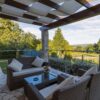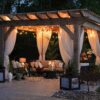The world of home and garden furniture is ever-evolving, blending timeless classics with modern innovations. Whether you’re redecorating a single room or curating an entire collection, finding design inspiration is key to creating a space that feels both personal and on-trend. In this blog, we share the latest trends, expert tips, and creative ideas to help you build a cohesive furniture collection for your home and garden.
Embracing a New Era of Design
Design trends in home and garden furniture are increasingly influenced by a desire for authenticity, sustainability, and versatility. Today’s consumers are looking for pieces that not only serve a functional purpose but also express their individuality and commitment to the environment.
The Influence of Nature
One of the most significant trends in recent years has been the incorporation of natural elements into design. From earthy tones to organic shapes, nature-inspired aesthetics create spaces that are both calming and invigorating.
Natural Materials: Think reclaimed wood, stone, and natural fibers. These materials bring an organic feel to your furniture, making your space feel grounded and timeless.
Biophilic Design: This design philosophy emphasizes a connection with nature. Integrate indoor plants, water features, and natural light to enhance your furniture’s appeal and create a refreshing ambiance.
The Blend of Vintage and Modern
Nostalgia and innovation can coexist beautifully in your furniture collection. Mixing vintage finds with contemporary designs creates layers of visual interest that tell a unique story.
Statement Pieces: Look for furniture that carries character—perhaps a vintage dining table or an antique accent chair. These items can serve as conversation starters and focal points in your space.
Modern Accents: Balance vintage pieces with modern designs that offer clean lines and functional features. The juxtaposition of old and new can create a dynamic, evolving look that never feels static.
Curating a Cohesive Collection
Curating a furniture collection that spans both home and garden spaces requires a thoughtful approach. Here are some tips to guide you through the process:
Start with a Vision
Before making any purchases, establish a clear vision for your space. Consider the following:
Define Your Aesthetic: Are you drawn to minimalist, industrial, or bohemian styles? Your aesthetic will guide your choices and help you build a collection that feels harmonious.
Consider Functionality: Think about how you will use each space. A well-designed garden might need casual seating for socializing, while your living room might call for a blend of comfort and sophistication.
Set a Budget: Quality furniture is an investment. Determine your budget early on to help narrow down your choices without sacrificing your design goals.
Mix and Match with Purpose
A curated collection doesn’t mean every piece must match perfectly. Instead, focus on creating a dialogue between different elements:
Color Schemes: Choose a color palette that runs through your entire collection. Consistent hues, even in different materials, help tie the collection together.
Material Harmony: Balance various textures—smooth metals, warm woods, soft fabrics—so that they complement each other rather than clash.
Scale and Proportion: Pay attention to the scale of each piece. Large, bold items should be balanced with more delicate, intricate pieces to create visual equilibrium.
Expert Tips for Furnishing Your Home & Garden
Achieving a truly inspiring space involves more than just selecting beautiful furniture. Consider these expert tips:
Emphasize Quality and Longevity
Invest in pieces that are built to last. High-quality furniture not only looks better over time but also offers lasting comfort and durability.
Research Brands: Look for brands that are known for their craftsmanship and commitment to sustainable practices.
Read Reviews: Customer feedback can provide insights into the longevity and real-world performance of a piece.
Stay Current with Trends, but Trust Your Instincts
While it’s important to stay informed about the latest trends, remember that your space should ultimately reflect your personal style.
Experiment with Accessories: Change up cushions, throws, or small accent pieces to keep your decor fresh without overhauling your entire collection.
Create Focal Points: Identify key pieces that will anchor your design. These might be a bold sofa, a striking garden bench, or an eye-catching coffee table.
Embrace Flexibility: Modular furniture and multi-functional pieces offer the versatility to adapt as your style evolves over time.
Bringing Outdoor Elegance Indoors
Many homeowners now look to extend their design aesthetic beyond the interior of their home to their outdoor spaces. The challenge is to create a seamless experience that flows from indoors to outdoors.
Designing Your Outdoor Space
Your garden or patio is an extension of your living space. Consider these ideas for creating an outdoor area that mirrors the quality and style of your indoor decor:
Select Weather-Resistant Furniture: Choose pieces that not only match your indoor aesthetic but are designed to withstand outdoor conditions. Look for materials that offer durability, such as treated wood, metal, or high-quality synthetic fibers.
Define Outdoor Zones: Create different zones for lounging, dining, and entertaining. This helps to organize your space and provides opportunities for varied experiences.
Use Lighting Creatively: Outdoor lighting is key to setting the mood. Incorporate string lights, lanterns, and built-in LED fixtures to create a warm, inviting atmosphere as the sun sets.
Integrating Indoor and Outdoor Collections
A cohesive design extends beyond the boundaries of your home. Here are some ways to integrate your indoor and outdoor furniture collections:
Consistent Design Elements: Use similar color schemes, materials, or design motifs in both indoor and outdoor spaces.
Flow and Transition: Ensure that furniture arrangements promote an effortless flow from the living room to the garden. Wide doorways, similar flooring, and complementary decor elements help bridge the gap.
Seasonal Adaptations: Consider how your furniture can adapt to seasonal changes. For instance, lightweight, modular outdoor furniture can be rearranged to suit different activities throughout the year.







